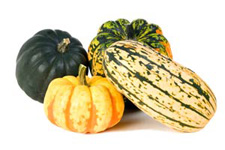Calories In Acorn Squash

Facts about the Calories in Acorn Squash
Besides being delicious and nutritious, it is good to know that the number of calories in acorn squash will fit into anyone’s diet plan. However, it does all depend on how the vegetable is prepared that will affect the caloric value in your next meal.
Winter vegetables, such as acorn squash, are much anticipated throughout the year. The inedible thick, hard rind that encases winter squash protects the flesh inside for long periods of time, making it ideal for storage. Acorn squash is one of the smallest varieties of winter squash, and its name is descriptive of its characteristics. Looking truly like a giant acorn, the squash generally begin to be harvested in the middle of the fall season. Intermittent splotches of either yellow or orange interrupt the overall green color of the squash that typically weighs around 3 to 4 pounds each. Cultivars of the acorn squash have been developed over time that offers different color varieties, such as white and gold.
Acorn squash has long been part of the human diet. There are records showing that the vegetable has been in existence dating back to thousands of years B.C., although it appears from those records that the flesh itself was not consumed. Only the seeds were considered to be a viable food source during that time. Growing wild throughout the United States, winter squash became a valued part of the diet of Native American people. It was not only used as a staple in the daily meals, but squash was also included in crypts of the dead to give them nourishment during their journey. The vegetable was later introduced to European settlers in the Americas. History shows that George Washington was an avid gardener of squash, as was Thomas Jefferson.
With such an extensive history, it is no surprise that people of today’s culture have enthusiastically included the winter vegetable in their menus as well. Prepared in its natural state by steaming or baking, squash is a highly nutritious vegetable. Just one cup of the vegetable prepared in this manner has only 115 calories. Acorn squash is absolutely devoid of any fat and cholesterol, making it a very healthy food choice. While there are trace amounts of natural sugars, the dietary fiber of 9 grams provides more than enough compensation to balance those. The daily recommended amounts of vitamins and nutrients may surprise some: 18% of Vitamin A; 37% of Vitamin C; 11% of iron and 9% of calcium. A source of potassium, thiamin, manganese, tryptophan and folate, this vegetable becomes even more of a nutritional value as a dietary staple.
Over time, recipes and methods of preparing squash have become more sophisticated; adding other ingredients with the flesh to make delectable casseroles, side dishes and even desserts. When additional elements are added, however, the amount of the calories in acorn squash dishes can change substantially. Many recipes call for the inclusion of salt, brown sugar, butter, oil and more that can alter the naturally nutritious vegetable into a dish of questionable nutritional value. When used in moderation, these additional ingredients can still result in a meal that is lower in calories. A lower calorie acorn squash pie, for example, can be made using yogurt, a light version of whipped topping, acorn squash pulp and pumpkin pie spice that results in a caloric count of 170 calories per slice with a homemade graham cracker crust.
A healthy diet can include many different dishes using the winter vegetables without worrying about the calories in acorn squash. Depending on how the squash is prepared, it can easily fit into the dietary needs of anyone.